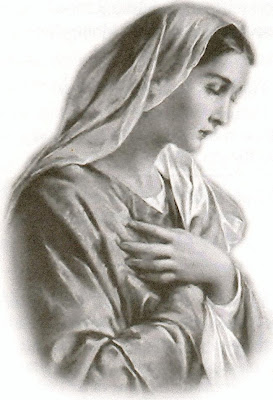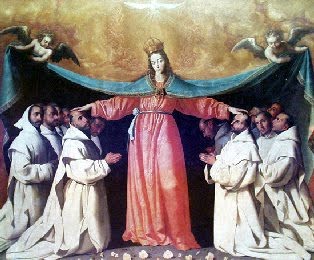 Our beloved founder worked strenuously for the glory of her who had chosen him from his childhood to be her apostle and servant. Together with his tender devotion to Mary, his children have also inherited his gratitude, and this is manifested as effectively as is permitted by their apostolate of the hidden life. Let us see what form this takes in the cloister.
Our beloved founder worked strenuously for the glory of her who had chosen him from his childhood to be her apostle and servant. Together with his tender devotion to Mary, his children have also inherited his gratitude, and this is manifested as effectively as is permitted by their apostolate of the hidden life. Let us see what form this takes in the cloister.After Saint Bruno, our principal exegetes – Denys the Carthusian, Ludolph of Saxony, Lanspergius among others – have held the dogma of the Immaculate Conception which was later to be proclaimed by the Church. And our historian Tromby (Benedetto Tromby: Storia del Patriarcha S. Brunone) even speaks of a manuscript entitled “Cartusia immaculata. . . the immaculate Charterhouse,” which recounts all that Carthusian authors have written in defense of Mary’s most beautiful privilege. For there has always existed in the Order a special zeal to propagate this doctrine, and His Holiness Saint Pius X, in his encyclical on the occasion of the Jubilee of the proclamation of the dogma, did Denys the Carthusian the great honor of borrowing his very words, in declaring the tradition of the Church on this point.
Our Ephemerides (Le Vasseur: Ephemerides Ordinis Cartusiensis) instance two of our Fathers who frequently declared themselves ready to undergo martyrdom to prove their belief in the grace of preservation from the stain of original sin accorded to the Virgin Mother of God. In the seventeenth century Dom Jean Pégon, whose generalate (Dom Jean Pégon was Prior of the Grande Chartreuse and 49th General of the Order from 1649-1675) had borne such exceptional fruit for the Order, had just received the Last Sacraments. Seeing his community gathered around him, he spoke to them of the principal mysteries of the Faith, especially of the Immaculate Conception, to which he had a particular devotion. And during his last illness, leaning on the arm of one of his monks, he used to kneel before the window of his cell, which opened on the side of the sanctuary of the chapel of Notre Dame de Casalibus, and there he would recommend to the heavenly Protectress of our Order all the needs of his religious family.
In the same century, the Charterhouse of Bosserville near Nancy was dedicated to the Immaculate Conception, and the proclamation of the dogma was solemnly celebrated there in 1854. A very simple but touching act of piety is related in this connection. A lay-brother of the House, Bruno Lhuillier, loved to preserve as long as possible the flowers that had been used for the festival, so dear were they to him because they had served to do honor to his Mother’s triumph.
And what a consolation it is to us, and what a cause for joy, to know that the feast of the Immaculate Conception in our Order dates back as far as the year 1333. It is true that the Statuta Nova of the year 1368 changed the term Conception first adopted to that of Sanctification, and that the General Chapter of 1406 continued to use this word to avoid all controversy. Nevertheless from 1418 onwards, the term Conception once more made its appearance in our liturgy, and was definitely restored in 1470.
If such was the Order’s zeal and fidelity shown in honoring the mystery of the Immaculate Conception, it was no less eager to celebrate that of the Visitation, as soon as the Holy See proposed this feast for the devotion of the faithful. In spite of the difficulties raised in the Church against the celebration of this feast proposed by Urban VI, and finally decreed by Pope Boniface IX, the Carthusians received it at once with holy joy.
The mere site of the titles under which our monasteries have been dedicated or known unfolds to our eyes a whole poem of faith and filial confidence. Out of the 260 or more Houses comprised in Monasticon (Maisons de l’Ordre des Chartreux), more than 120 have the honor of bearing the name of Mary; and under what varied and charming titles! Such are, for instance, the Door, the House, the Castle, the Cloister, the Cell, the Temple, the Court, the Throne, the Burning Bush of Mary. They are her Mountain, her Valley, her Park, her Garden, her Fountain, her Stream, her Gate. Our Lady is represented therein as the Way, the Door, the Peace of Paradise, the Queen of Heaven, the Mother of Mercy, the Court of God the Father, the Altar of Christ, the Lily of the Holy Spirit. None of the mysteries of her life are forgotten. Three Houses are dedicated to her Immaculate Conception; others to her Annunciation, her Visitation, Purification, Compassion, Assumption, Coronation. . . not forgetting the singularly expressive and confiding title of the Blessed Virgin Mary in the Valley of Josaphat.
What more can we say? Out of about four hundred seals of our Houses that have been recovered, two hundred bear some representation, monogram or legend in Mary’s honor. We can count no less than 168 Carthusian writers, who have composed in Mary’s praise some 335 works in different languages, without reckoning numerous reprints and translations.
And how about many touching incidents do we find in the devotion which so many devoted religious of the Order have shown for the Mother of our Savior. In this little work we shall content ourselves with recalling only the following, culled from the lives of three of our Fathers who have been raised to the altar.
What a delicacy of love and respect we see in the last directions given by Saint Hugh of Lincoln, that after his death his body should be washed, in honor of the church of our blessed Lady where he was to be buried (Le Vasseur: Ephemerides, Vol. IV).
Saint Stephen, Bishop of Die, formerly Prior of the Charterhouse of Portes, also wished to be laid to rest in the chapel of his cathedral dedicated to the Mother of God. And as he died on 7 September (the year was 1208), many miracles were worked from his tomb from the morrow onwards – the feast of the Nativity of Mary, a feast which he had the happiness of keeping with her, it is hoped, in heaven (Le Vasseur: Ephemerides, Vol. III).
Blessed Nicholas Albergati, Cardinal-Archbishop of Bologna, and formerly a simple monk of the Charterhouse of that city, seeing in 1433 his diocese ravaged by earthquakes and torrential rains, ordered three days of public prayer at the sanctuary of La Guardia, where there was preserved, it is said, the authentic picture of our Lady painted by Saint Luke. The venerated image was carried in procession during these three days to the churches of Bologna, and the scourged ceased (Cavallo: Life of Blessed Nicholas Albergati).
~ Dom Louis-Marie Rouvier ~











